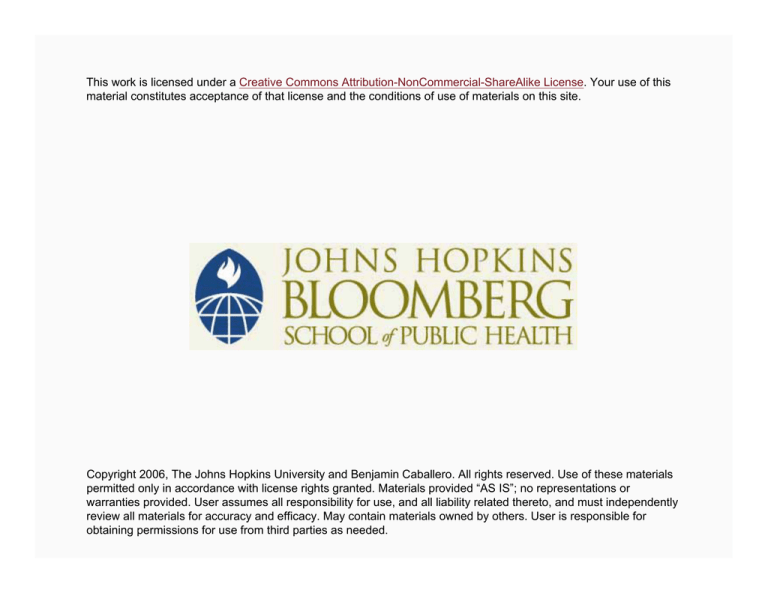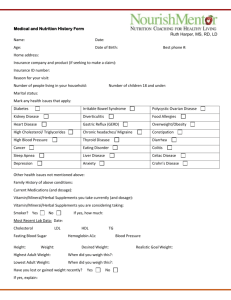
This work is licensed under a Creative Commons Attribution-NonCommercial-ShareAlike License. Your use of this
material constitutes acceptance of that license and the conditions of use of materials on this site.
Copyright 2006, The Johns Hopkins University and Benjamin Caballero. All rights reserved. Use of these materials
permitted only in accordance with license rights granted. Materials provided “AS IS”; no representations or
warranties provided. User assumes all responsibility for use, and all liability related thereto, and must independently
review all materials for accuracy and efficacy. May contain materials owned by others. User is responsible for
obtaining permissions for use from third parties as needed.
Antioxidant Nutrients
Benjamin Caballero, MD, PhD
Johns Hopkins University
Section A
Antioxidant Nutrients
Antioxidant Nutrients
Ascorbic acid
Alpha-tocopherol
Beta-carotene
Selenium
Manganese
4
Oxidants and Antioxidants
Pro-Oxidants
Substrate oxidation
Antimicrobial defense
Radiation
Sunlight
Ionized compounds
Aging
Oxygen
Antioxidants
Free radical scavengers:
−Extracellular/
circulating
−Cellular
X Cytosolic
X Membrane-bound
5
What Is a Free Radical?
An unbound compound (i.e., free) having one or more
unpaired electrons
R
O
H
O H
Hydroxyl group
Hydroxyl radical
(good guy)
(bad guy)
6
Examples of Free Radicals and their Half-Lives
Hydroxyl radical
Singlet oxygen
Alkoxyl radical
RO•
Peroxyl radical
Semiquinone radical Q•-
HO•
1
O2
ROO•
1 x 10-9 sec.
1 x 10-6
1 x 10-6
7
days
7
Free Radical Formation
Oxidation of substrates with high oxygen affinity (for
example, fatty acids)
Microbial lysis
Environmental exposure (sunlight, radiation, high-oxygen
levels)
8
Antioxidant Systems of Physiological Relevance in Humans
Water-Soluble
− Ascorbate
− Glutathione
− Urate
− Bilirubin
9
Antioxidant Systems of Physiological Relevance in Humans
Lipid-soluble
− Alpha-tocopherol
− Beta-carotene
− Lycopene
− Lutein
− Zeaxanthin
− Ubiquinol-10
10
Antioxidant Systems in Cells
11
Antioxidant Defense Processes
Prevention—Balance between oxidative load and
antioxidant function
Interception—Local antioxidant levels
Repair—Mostly enzymatic
12
Antioxidant Defense Processes
Prevention—Vitamin E, ascorbic acid, beta-carotene
Interception—Vitamin E, glutathione, superoxide dismutase
Repair—DNA repair system, reductases
13
Role of Nutrients in Antioxidant Systems
Vitamin E
− Protects lipids from the cell membrane bilayer from
attack by free radicals
Vitamin C
− Quenches 1O2 in cytosol
− Recycles vitamin E after it captures free radicals
14
Role of Nutrients in Antioxidant Systems
Carotenoids
− Beta-carotene quenches 1O2; may also inhibit free-radicalgenerating reactions
− Autoregenerate with release of thermal energy
15
Role of Nutrients in Antioxidant Systems
Selenium
− Constituent of glutathione peroxidase
Manganese
− Constituent of superoxide dismutase (MnSOD)
Copper, zinc
− Constituents of superoxide dismutase (CuZnSOD)
16
Antioxidant Mechanism of Vitamin E
LOOH
k ~ 102
LOO•
Chain
reaction!
•
Vitamin C
17
“Protective” Intake Levels of Antioxidant Nutrients
Vitamin C
Vitamin E
Selenium
Protective
level*
RDA
>600 mg
>200 IU
70–120 µg
60
10
70
* Daily intakes associated with a risk reduction of 25% or more
18
Section B
Diet and Chronic Diseases
Evolution of the Human Diet
HunterGatherers
15–20
50–70
15–20
Salt (g/day) 1
Fiber (g/day) 40
Peasant
Modern Affluent
Agriculturists
Societies
10–15
5
40+
60–75
20
Sugar
25–30
Starch
10–15
12
Protein
5–15
60–120
10
20
Fat
20
Nutrition Transition Fat Consumption Patterns—Japan
50
% Fat Energy
45
40
35
30
25
20
15
10
5
0
1946 1950 1955 1960 1965 1970 1975 1980 1990
Notes Available
21
Diet Constituents Implicated on Disease Risk
Fats
Cholesterol
Fiber
Antioxidant vitamins and
minerals
Sugar
Protein
Calcium and vitamin D
Folic acid
Iron
22
Criteria for Diet-Disease Relationships
Strength of association
Dose-response relationship
Temporally correct association
Consistency of association
Specificity of association
Biological plausibility
Notes Available
185-01 23
Dietary Fat Intake and Breast Cancer-Related Deaths
Notes Available
24
Fish Consumption and Risk of CVD
Fish Consumption, g/day
0
<18
18–34 >35
MI
1.0
0.88
0.76
0.56
CHD
1.0
0.88
0.84
0.62
CVD
1.0
0.94
0.89
0.74
All causes
1.0
1.02
0.98
0.85
Notes Available
25
Diet and Blood Pressure
Sodium
Calcium
Potassium
Magnesium
Alcohol
26
The DASH Study
S y s to lic B P
132
130
Control
128
Fruits and Veg.
126
124
DASH diet
122
120
BL
1
2
3
4
5
6
7
Weeks
Notes Available
27
Dietary Patterns and Blood Pressure: The DASH Diet
Control
F&V
DASH
Fat (% cal)
36
36
26
Cholesterol (mg)
233
184
150
Fiber (g)
9
31
31
Potassium (mg)
1752
4101
4415
Magnesium (mg) 176
423
480
Calcium (mg)
443
534
1265
Sodium (mg)
3028
2816
2859
28
Section C
Fats and Cardiovascular Disease
Serum Cholesterol and Coronary Heart Disease
CHD Incidence
125
100
75
50
25
0
< 204
205-234
235-264
265-294
> 295
Serum C holesterol (m g/100m L )
Notes Available
30
Cholesterol and CVD
The cholesterol hypothesis of coronary heart disease
Dietary cholesterol, blood cholesterol, and atherosclerosis
Dietary factors affecting blood cholesterol levels
Non-dietary factors affecting blood cholesterol levels
31
Coronary Heart Disease
Relative Risk
Serum LDL and CHD Risk
2.5
2
1.5
men
women
1
0.5
0
200
1
300
2
400
3
500
4
5600
Serum LDL (mg/dL)
Notes Available
32
Serum HDL and CHD
Morbidity Ratio
200
150
m en
wom en
100
50
0
20
30
40
50
60
70
75+
Serum HDL Concentration
(mg/dL)
Notes Available
33
Diet and Atherosclerosis
Low-fat diets
− Lower blood cholesterol but also tend to lower LDL and
HDL
Low-saturated, high-monounsaturated diets
− Lower blood cholesterol and LDL, tend to increase HDL
34
Diet and Atherosclerosis
High-carbohydrate diets
− Modest lowering effect on all lipid fractions, but rise in TG
Fish oils
− Strong lowering effect on blood TG, but minor effect of
lipoprotein fractions
35
Dietary Factors Affecting Blood Cholesterol
Increase
− Saturated fat
− Cholesterol
− Trans fatty acids
Decrease
− Monounsaturated fat
− PUFA (fish oil)
− Fiber
36
Non-Dietary Factors Affecting Blood Cholesterol
Increase
− Smoking
− Excess body fat
− Alcohol
Decrease
− Exercise
− Estrogens
37
Other Nutrients Associated with Risk of CHD
Folic acid
Vitamins B6 and B12
Iron
38
Folate and Vitamin B: Interrelationships
Homocysteine
Methyl-THF
B 12
Methionine
THF
B6
5,10-methylene-THF
Copyright 2005, Benjamin Caballero and The Johns Hopkins University. All rights reserved. Use of these materials permitted
only in accordance with license rights granted. Materials provided “AS IS”; no representations or warranties provided. User
assumes all responsibility for use, and all liability related thereto, and must independently review all materials for accuracy
and efficacy. May contain materials owned by others. User is responsible for obtaining permissions for use from third parties
as needed.
39





